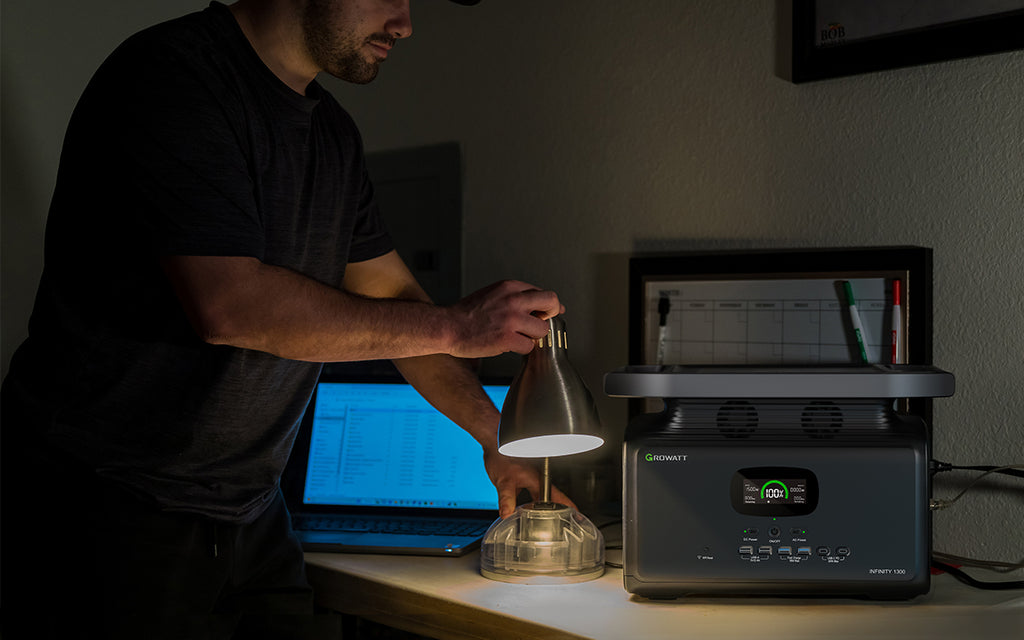An Emergency Power Supply (EPS) and an Uninterruptible Power Supply (UPS) both use rechargeable batteries to provide backup power, but there are important differences between them. In this article, we will discuss the similarities and differences between an EPS and UPS, while providing some examples of when to use each type of system.
In a few words, an Uninterruptible Power Supply (UPS) is used to protect sensitive electronic equipment that contains important data, such as computers and medical equipment. On the other hand, an Emergency Power Supply (EPS) is used to power equipment that keeps people safe during emergencies, such as fire protection systems.

What Is an EPS?
An Emergency Power Supply (EPS) is a system that provides electricity for important equipment during emergencies that cause an interruption of grid power. EPS systems can be designed to run with batteries, but you can also find systems that use conventional generators or a combination of batteries and generators. However, EPS systems that use batteries have several advantages:
- Batteries can respond faster than generators when there is a power outage.
- Batteries don’t produce combustion gases, which makes them a safer option.
- Batteries require less space, since they don’t need a fuel tank.
An EPS is designed to operate online, independently from the local power grid. When there is an emergency condition that causes a power outage, fire protection systems and other critical equipment are switched to the EPS so they can continue operating.
EPS systems are capable of powering all types of electrical loads. However, you must make sure that the total load connected to the EPS does not exceed its rated power output:
- Inductive loads: These are electrical loads with magnetic fields, such as pump motors and transformers. Some lighting fixtures are also inductive loads.
- Capacitive loads: These are electrical loads with batteries and capacitors, such as computers and many types of electronic equipment.
- Resistive loads: These electrical devices consist of pure electrical resistance, without any inductive or capacitive loads. Incandescent lamps and resistance heaters are two examples of resistive loads.
Typical Applications of EPS Systems
In general, an EPS is used to power equipment that is important for human safety. This includes fire protection systems such as the following:
- Fire sprinkler pumps
- Fire and smoke alarms
- Smoke extractor fans
- Exit signs and emergency lighting
Fire protection systems have many electrical components. An EPS ensures that these systems continue operating if the building’s power supply is damaged during a fire, or if there is a power outage for any other reason. Without an EPS, power interruptions occuring during a fire would disable many protection systems, leaving the building and its occupants fully exposed.
In most buildings, the main function of an EPS is providing backup power for fire protection systems. However, they can also be used to power other important devices such as elevators and emergency lifts. An EPS can also be used to power air conditioning or refrigeration systems for areas that require temperature control at all times.
What Is a UPS?
An Uninterruptible Power Supply (UPS) is also used as a backup power source, but its main function is protecting sensitive electronic equipment and important data.
- Unlike an EPS which is normally offline, a UPS is permanently connected.
- When there is a power interruption, the electrical devices connected to a UPS can be switched to backup power almost instantly.
In addition to providing backup power without interruption, modern UPS systems also include voltage regulation and surge protection functions. These features keep your electronic equipment safe from voltage disturbances, which often occur along with power outages. Voltage spikes can also happen when power outages affect other areas of the grid, even if your building is outside of the affected zone.
Unlike an EPS, which can power all types of electrical loads, a UPS is normally designed only for capacitive and resistive loads. You should not connect motors and transformers to a UPS, since they are inductive loads that can damage the system.

Typical Applications of UPS Systems
A UPS is used to protect sensitive electronic equipment from power outages and voltage disturbances. The following are some equipment types that are normally protected by a UPS:
- Computers
- Data centers
- Telecommunication equipment
- Electronic healthcare equipment
As you can see, these are applications where data loss or equipment malfunctions can have severe consequences. If a data center running critical applications shuts down unexpectedly, the companies using it can face major financial losses. The same applies for medical equipment, where a power interruption can threaten the life of patients.
Key Differences Between EPS and UPS Systems
Both EPS and UPS systems use batteries to provide backup power for different types of equipment, but there are important differences between them:
|
Type of System |
Emergency Power Supply (EPS) |
Uninterruptible Power Supply (UPS) |
|
Typical applications |
Providing backup power for fire protection systems and other important equipment that does not involve sensitive electronic components or critical data. |
Protecting data and providing backup power for sensitive electronic devices with critical functions, including: computers, data centers, telecom equipment and medical equipment. |
|
Functions |
Backup power with batteries, may also include conventional generators. |
Backup power with batteries, and additional functions such as voltage regulation and surge protection. |
|
Response time |
Up to 250 milliseconds. |
0 to 12 milliseconds, almost instant. |
|
Electrical loads |
All types: Inductive, capacitive and resistive loads. |
Only capacitive and resistive loads. |
|
Electrical connection |
Normally offline, only activates during an emergency. |
Permanently online, and electronic devices connected to the UPS are switched over instantly. |
If you compare an EPS and UPS of the same capacity, the UPS system will normally have a higher price. However, EPS systems are normally larger than UPS systems, since they are designed for larger loads such as fire pumps and emergency lifts. As a result, EPS systems tend to have a higher total cost, but a lower cost per kilowatt of capacity.
Advantages of EPS Systems
- Simple and reliable: Since an Emergency Power Supply only provides backup power, it has a simpler configuration than an Uninterruptible Power Supply.
- Cost-effective in the right applications: An EPS is a more affordable option for equipment without sensitive electronic parts, or equipment that does not handle critical data.
- Energy efficiency: Since an EPS system is normally offline, its electricity and fuel consumption are zero most of the time.
Advantages of UPS Systems
- Seamless power continuity: Since a UPS is permanently online, it can switch your critical devices to backup power in an instant. UPS systems can switch over in 12 milliseconds or less.
- Prevent voltage fluctuations: A UPS not only provides backup power, but also permanent protection against voltage disturbances coming from the grid and other areas of your building.
- Suitable for sensitive electronics: UPS systems provide voltage regulation and a stable power output, which makes them suitable for electronic devices that don’t tolerate power fluctuations.
EPS vs UPS: Which One Should I Choose?
The main factor that determines the choice between an EPS and UPS is the type of equipment you need to power. In both cases, you must make sure that the EPS or UPS can provide a high enough wattage for all the devices connected. Here is a quick guide to help you choose between an EPS and UPS:
|
Equipment that Requires an EPS |
Equipment that Requires a UPS |
|
Fire pumps Sprinkler booster pumps Fire alarms Smoke dampers Smoke extractors Elevators Emergency lighting and exit signs Emergency lifts Heating and cooling equipment in critical areas that require 24/7 temperature control |
Computers Data centers Network equipment Telecommunications equipment Medical equipment Security and law enforcement equipment Bank equipment |
EPS and UPS systems both power important devices. However, EPS systems have a simpler configuration that does not include voltage regulation and surge protection. EPS systems also have a slower response: they can take up to 250 milliseconds, while UPS systems are designed to respond in less than 12 milliseconds.
The cost of EPS and UPS equipment can vary widely, from a few thousand dollars in small-scale applications, to hundreds of thousands in a large building with plenty of critical equipment. To determine the exact cost of your EPS or UPS system, the best recommendation is getting a professional assessment of your backup power needs.

Conclusion
EPS and UPS systems are both used to keep important equipment running during power outages. An EPS is a simpler system that only provides backup power but no voltage regulation, and it can be used to power all types of electrical loads. On the other hand, a UPS provides voltage regulation along with backup power, which makes it suitable for sensitive electronic equipment. However, a UPS is not designed for inductive loads such as pump motors and equipment transformers. A UPS is also much faster than an EPS, which makes it suitable for applications where even a short power interruption can compromise important data.
In general, EPS and UPS systems are intended for special applications and specific equipment. If you want a backup power system for your home appliances during blackouts, you can rely on a portable power station from Growatt. Our backup battery systems can be recharged by solar panels, grid power, or by car. And some of our portable power solutions include the EPS feature, which ensures continuous power supply in the event of an emergency.






